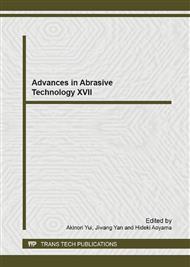p.193
p.199
p.205
p.212
p.218
p.222
p.228
p.237
p.243
Radial Directional Vibration-Assisted Ductile-Mode Grinding of Engineering Ceramic
Abstract:
Engineering ceramics have received significant attention in the recent years owing to their exceptional mechanical properties, which are expected to be beneficial for engineering applications. However, it has always been a great challenge to realize ductile-mode grinding in engineering ceramics, with one of the critical obstacles being the heat generation that limits the removal rate. As a result, thermal damages are often observed on the ground surfaces. This paper presents the ductile-mode grinding. In the process the grinding wheel is excited along the radial direction by applying an ultrasonic vibration of frequency is 38.5 kHz and amplitude of 0-2 μm. The wheel comes in contact with the Al2O3 ceramic at constant forces 18-24 N. Experimental results indicate that the ground surface is devoid of thermal damages, when removal rate of the vibration-assisted process is approximately 1.5 times higher than without vibration.Keywords: ductile-mode grinding, radial directional vibration, hard and brittle material, engineering ceramic, thermal damage
Info:
Periodical:
Pages:
218-221
Citation:
Online since:
September 2014
Authors:
Price:
Сopyright:
© 2014 Trans Tech Publications Ltd. All Rights Reserved
Share:
Citation:


